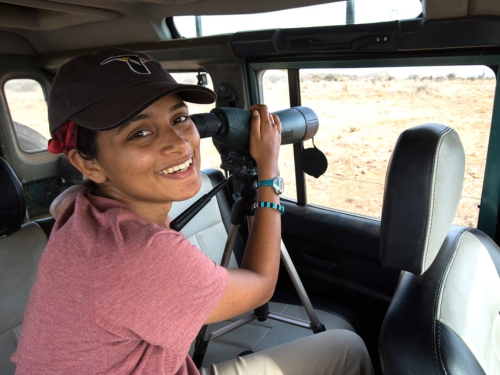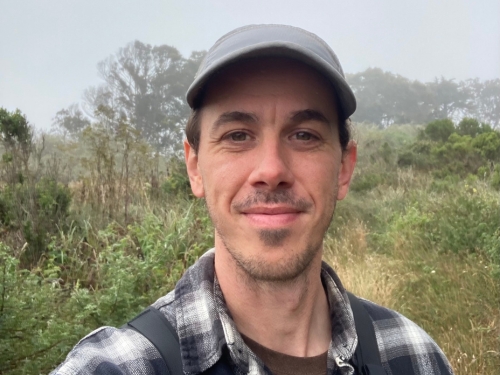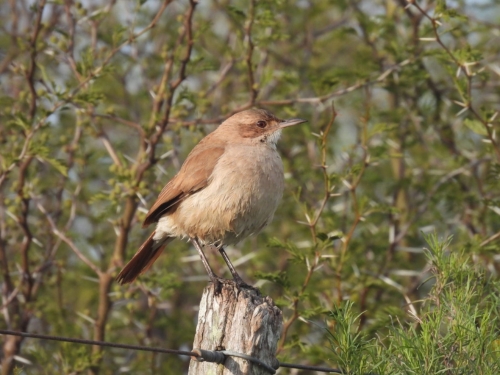The American Ornithological Society (AOS) is pleased to announce the awardees of the 2023 Kessel Research Fellowship for early-career researchers. Four $15,000 fellowships were awarded to Lucia Mentesana, Facundo X. Palacio, Shailee Shah, and Frank Fogarty to support their ornithological research. “The Kessel Committee is delighted to support the innovative research of these four early-career scientists. Their research will advance ornithology in several countries across a range of fields including conservation, behavior, evolution, and ecology. The Committee wishes every success to the awardees!” says this year’s Kessel Fellowship Selection Subcommittee chair Sabrina Taylor.
These fellowships, made possible through a generous bequest by Dr. Brina Kessel, support the full range of ornithological research currently published in peer-reviewed journals, such as avian biology, ecology, behavior, conservation, genetics, and interdisciplinary work.
Congratulations to these awardees! Read on for more information about the researchers and the projects being funded by this year’s Kessel Research Fellowships.

Dr. Lucia Mentesana
Postdoc, Faculty of Sciences, Republic University, Uruguay (Facultad de Ciencias, Universidad de la Republica)
Dr. Lucia Mentesana completed her undergraduate studies and began her academic career at the University of Buenos Aires in Argentina, and received her Ph.D. from the Max Planck Institute for Ornithology in Germany. Her doctoral research focused on the association of early-life and adult environments with physiology, morphology, and fitness in Great Tits (Parus major). In parallel to her Ph.D., she conducted two independent research projects on the Rufous Hornero (Furnarius rufus). One of these projects, HORNERO, was a citizen science initiative collecting data from 1,300 participants across five South American countries. In her first postdoc experience at the Max Planck Institute for Biological Intelligence in collaboration with the University of Bielefeld, she studied the fitness consequences of egg yolk steroid hormones in wild birds using phylogenetic multilevel meta-analyses. Dr. Mentesana recently moved to Uruguay, where she will carry out her second postdoc in Republic University’s Faculty of Sciences. She is interested in understanding the mechanisms that allow organisms to cope with environmental changes. For this, she studies the interplay between behavior, physiology, ecology, and evolution. Over the years, Dr. Mentesana secured grants from the International IMPRS for Organismal Biology and IDEA WILD for independent projects on the Rufous Hornero. She also recently obtained a grant from the Ministry of Science of Argentina for a new citizen science project with the same study species.
Project: “Spatial personality, aggressive behavior, and reproductive success in a neotropical bird”
Abstract: The way animals use space affects their fitness by mediating their ability to cope with environmental changes. Space use also shapes ecological processes by influencing the way organisms interact with others, with implications for wildlife conservation and management. Although much research has focused on documenting spatial behaviors of populations and species, our knowledge about the evolutionary ecology of individual spatial behaviors remains largely unexplored. Spatial personalities may be explained by individuals with consistent differences across time and context in behaviors other than space use, termed animal personalities. However, studies on personality-dependent space use in natural ecosystems remain extremely rare because it is difficult to obtain paired data sets on spatial dynamics and repeated behaviors from wild individuals. Spatial personalities may also originate from individuals experiencing differences in social interactions, certain habitat features, and/or resources. The Kessel Fellowship will allow me to carry out a unique research project that combines state-of-the-art animal tracking technology with behavioral and reproductive success data to investigate the among-individual differences in spatial behaviors, the contributions of animal personality and environmental characteristics to spatial personalities, and their link to reproductive success in a year-round territorial bird, the Rufous Hornero (Furnarius rufus).
Twitter: https://twitter.com/nidohorneros
Instagram: https://www.instagram.com/nidohorneros/
ORCID ID: https://orcid.org/0000-0003-4090-2570

Dr. Facundo X. Palacio
Assistant Researcher, Sección Ornitología, Facultad de Ciencias Naturales y Museo, Universidad Nacional de La Plata
Dr. Facundo X. Palacio is an accomplished ornithologist and ecologist whose dedication to avian research has made a significant impact on the field. He holds a B.Sc. in Biology from Universidad Nacional de La Plata, Argentina, and a Ph.D. in Biological Sciences from Universidad Nacional de Tucumán, Argentina. Currently associated with Museo de La Plata, Universidad Nacional de La Plata, Dr. Palacio focuses on the evolutionary ecology of plant-bird interactions and the effects of anthropogenic change on bird ecosystem functioning. His work has garnered recognition for its innovative approaches to avian ecology research.
Over the years, Dr. Palacio has received several awards, including an AOS Postdoctoral Research Award in 2020, and an Outstanding Young Researcher in Natural Sciences Award from Félix de Azara Natural History Foundation in 2023. Dr. Palacio has a substantial publication record and a history of presenting his research at international conferences. With a passion for the natural world and a commitment to scientific excellence, he continues to make substantial strides in the field of ornithology, working tirelessly to ensure a brighter future for the world’s feathered inhabitants.
In 2019, Dr. Palacio authored a book on multivariate analysis. Coincidentally, he later met James Rohlf and Douglas Futuyman on the same day while in the U.S. “The highlight was an unforgettable morning bird watching adventure with Douglas near Stonybrook—a day I’ll cherish forever!” he reminisces.
Project: “The importance of intraspecific variability in functional traits for bird and plant communities”
Abstract: The use of species traits as proxies for their ecosystem functions has greatly advanced our understanding of the structure and dynamics of biological communities, as well as their response to environmental change. In the vast majority of cases, this approach implicitly assumes that interspecific variation in these traits is greater than intraspecific variation when using trait means. However, intraspecific variation can be equal to or even greater in magnitude than interspecific variation, with significant implications for estimating functional diversity. Therefore, this proposal aims to determine the role of intraspecific variation in functional traits and its impact on the functional diversity of biological communities. To achieve this, a highly invasive plant species (Ligustrum lucidum) and the associated bird and woody communities in forests in the province of Buenos Aires, Argentina, will be used as a study system. Through the characterization of functional traits of bird species (diet, foraging behavior) and woody species (height, leaf dry weight, seed mass), I will investigate how intraspecific variation in these traits shapes the communities of both taxonomic groups and affects the estimation of functional diversity. This will be accomplished through analyses that explicitly incorporate intraspecific variation in functional diversity to establish advantages, limitations, and general guidelines for the appropriate use of each approach. Collectively, this research aims to understand the ecological effects of intraspecific variation from both empirical and methodological perspectives and to predict the consequences of biodiversity loss and species responses to environmental change.
Twitter: https://twitter.com/facupalacio12

Dr. Shailee Shah
Postdoctoral Fellow, Cornell Lab of Ornithology
Dr. Shailee Shah is a postdoctoral fellow at the Cornell Lab of Ornithology at Cornell University. She received a bachelor’s degree in biology from Cornell University in 2014, and a Ph.D. from Columbia University in 2022. As a Ph.D. student, she investigated the socioecological drivers of sociality in an obligate, plural cooperative breeder, the Superb Starling (Lamprotornis superbus), found in East Africa, which was funded in part by an AOS Van Tyne Research Award. After receiving her doctoral degree, Dr. Shah worked as a postdoctoral research associate at the University of Rochester, investigating dispersal at both the within- and across-population levels in the Florida Scrub Jay (Aphelocoma coerulescens). In September 2023, Dr. Shah returned to Cornell as a National Science Foundation (NSF) Postdoctoral Fellow, where she is excited to start working on a new project investigating the impact of sociality on the evolutionary dynamics of superb starlings. The Kessel Fellowship will fund a large part of the genomic work for this new project. Dr. Shah has also been heavily involved with the AOS for many years, serving on—and chairing—the Student Affairs Committee, serving on the Diversity and Inclusion (D&I) committee, and organizing workshops during multiple AOS meetings.
Dr. Shah is a 2019 recipient of the AOS Josselyn Van Tyne Memorial Research Grant, and AOS Student Travel Grants in 2017, 2019, and 2023. Her “spark bird” is the White-browed Fantail (Rhipidura aureola), which she grew up watching in the woodlands outside the city of Ahmedabad, India.
Project: “How does sociality impact evolution?”
Abstract: While the causes underlying the evolution of animal societies have attracted much scientific attention, sociality can also have important evolutionary consequences. By governing the distribution of individuals over space and time, sociality can play a key role in mediating the evolutionary processes acting on a population. In cooperatively breeding species, groups were traditionally thought to comprise a single breeding pair and older offspring that helped raise younger siblings instead of dispersing to breed independently. In such species, limited intergroup movement of genes and fewer breeding individuals can reduce genetic variation, decreasing adaptive capacity and increasing extinction risk. However, we now know that in many species—including half of all cooperatively breeding birds—unrelated immigrants, not older offspring, comprise a significant proportion of the group, often breeding alongside natal individuals. While species with such complex social structure should, theoretically, experience increased genetic variation due to more intergroup movement of genes and more breeding individuals within social groups, the relationship is likely more nuanced. Environmental factors can, for example, regulate movement of individuals between groups and their reproductive opportunities, affecting the distribution of genes over space and time. I will investigate how spatiotemporal variation in complexity of social structure impacts allele frequency dynamics in a cooperatively breeding bird, the Superb Starling (Lamprotornis superbus). First, leveraging a >20-yr dataset from nine groups within a population in central Kenya, I will examine how temporal variation in social structure, driven by the impact of rainfall on immigration and reproduction, results in changes in allele frequencies over time. Next, using genomic data from populations at eight sites spanning a country-wide rainfall gradient, I will examine the impact of spatial variation in social complexity on the relative strength of different evolutionary processes within the same species. Overall, my research will reveal how variation in a key behavioral trait—sociality—impacts allele frequency change over time—i.e., genetic evolution. Understanding how behavior can mediate the relationship between ecology and evolution is crucial for predicting how species will respond to future environmental scenarios.
Twitter: https://twitter.com/shailee_shah93
ORCID ID: https://orcid.org/0000-0003-2411-6318

Dr. Frank Fogarty III
Assistant Professor, Cal Poly Humboldt
Dr. Frank Fogarty studies how potential disturbances, including wildfire, climate change, habitat fragmentation, timber harvest, and cattle grazing, interact with birds and their communities. He is also interested in methodologies for evaluating occupancy and abundance, and incorporates his expertise as a field biologist to examine model performance using the kinds of messy, realistic data that are used by wildlife professionals. Dr. Fogarty is also deeply committed to his work as a teacher and leveraging his position to help the field of wildlife biology become more inclusive and equitable. In the Applied Avian Ecology Lab at Cal Poly Humboldt, he works closely with undergraduate and graduate students to pair intriguing questions with cutting-edge modeling techniques to produce results that are robust, realistic, and applicable to management. Ongoing work in his lab has been supported by grants from the Oregon Department of Fish and Wildlife’s Oregon Conservation and Recreation Fund, the Pittman–Robertson Wildlife Restoration Act (now the Federal Aid in Wildlife Restoration), and the National Council for Air and Stream Improvement. Dr. Fogarty received a Ph.D. in Ecology from the University of California, Davis, under the supervision of Dr. Erica Fleishman; an M.S. and M.P.P. from the University of Maryland, College Park; and a B.S. from the University of Florida. Dr. Fogarty is an avid amateur rock climber and gardener; hobbies that are “constantly eating into my birding time,” he says.
Project: “Evaluating the effects of habitat connectivity and wildfire on the migratory behavior of a species of conservation concern”
Abstract: Despite being a species of conservation concern in Oregon, there are many persistent knowledge gaps about the ecology of Lewis’s Woodpecker (Melanerpes lewis), a species that has declined sharply in abundance since the 1960s. Additionally, many populations appear to have altered their migratory behavior over the last century and extrinsic factors that may contribute to individual and population level migratory behaviors remain unexamined. Migratory pathways, wintering ranges, and connectivity between Lewis’s Woodpecker populations are also poorly understood, as are the true proportion of resident, non-migratory individuals in the state. These are key knowledge gaps for effective, full-life cycle conservation of these populations.
In Oregon, Lewis’s Woodpeckers primarily nest in dead conifer snags (often ponderosa pine, Pinus ponderosa) in relatively open, burned areas. However, the species also uses live Oregon white oak (Quercus garryana) for nesting and is reliant on its acorns as a winter food source. Therefore, questions remain about the importance of connectivity between post-burn pine-oak woodland and live oaks for maintaining year-round populations. Given that only 2–8% of open ponderosa pine habitat remains in eastern Oregon, successful management of this land cover likely is critical to the persistence of Lewis’s Woodpeckers in the state.
We will use a combination of point count and telemetry data to evaluate the following research questions:
- What proportion of key land cover types (e.g., ponderosa pine, Oregon white oak) are included in Lewis’s Woodpecker home ranges?;
- Is connectivity of land cover types an important predictor of breeding territory occupancy and year-round occupancy?;
- Does recent fire history impact habitat usage?;
- What proportion of birds remain year-round in Oregon, and do home ranges or habitat use shift between breeding season and winter for over-wintering birds?
The results of this work will help managers better understand the habitat requirements of this declining species, and particularly inform efforts to maintain or restore suitable year-round habitat for Lewis’s Woodpecker. Additionally, it will add significant information to our understanding of this species’ migratory behavior and connectivity across Oregon and surrounding states, and would be one of the few studies to examine how extrinsic factors are correlated with partial migration in a temperate land bird.



